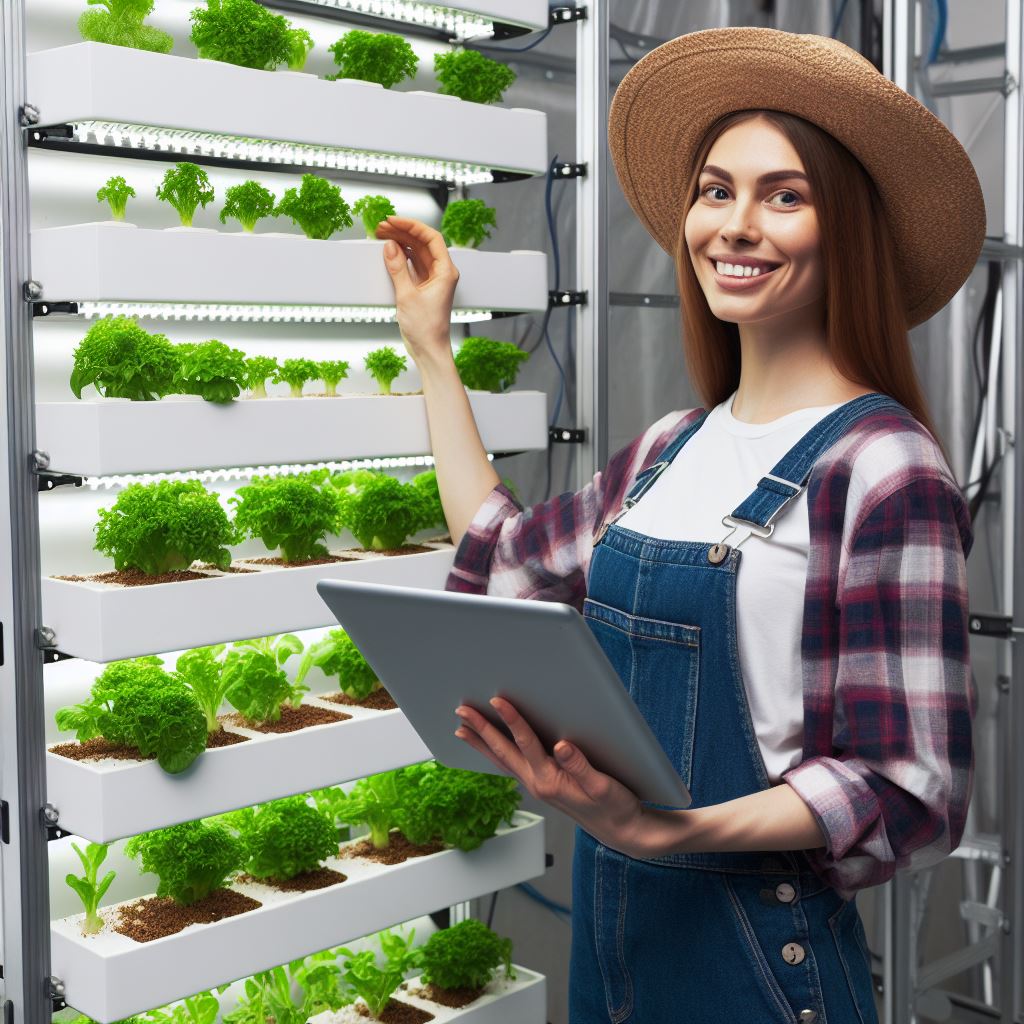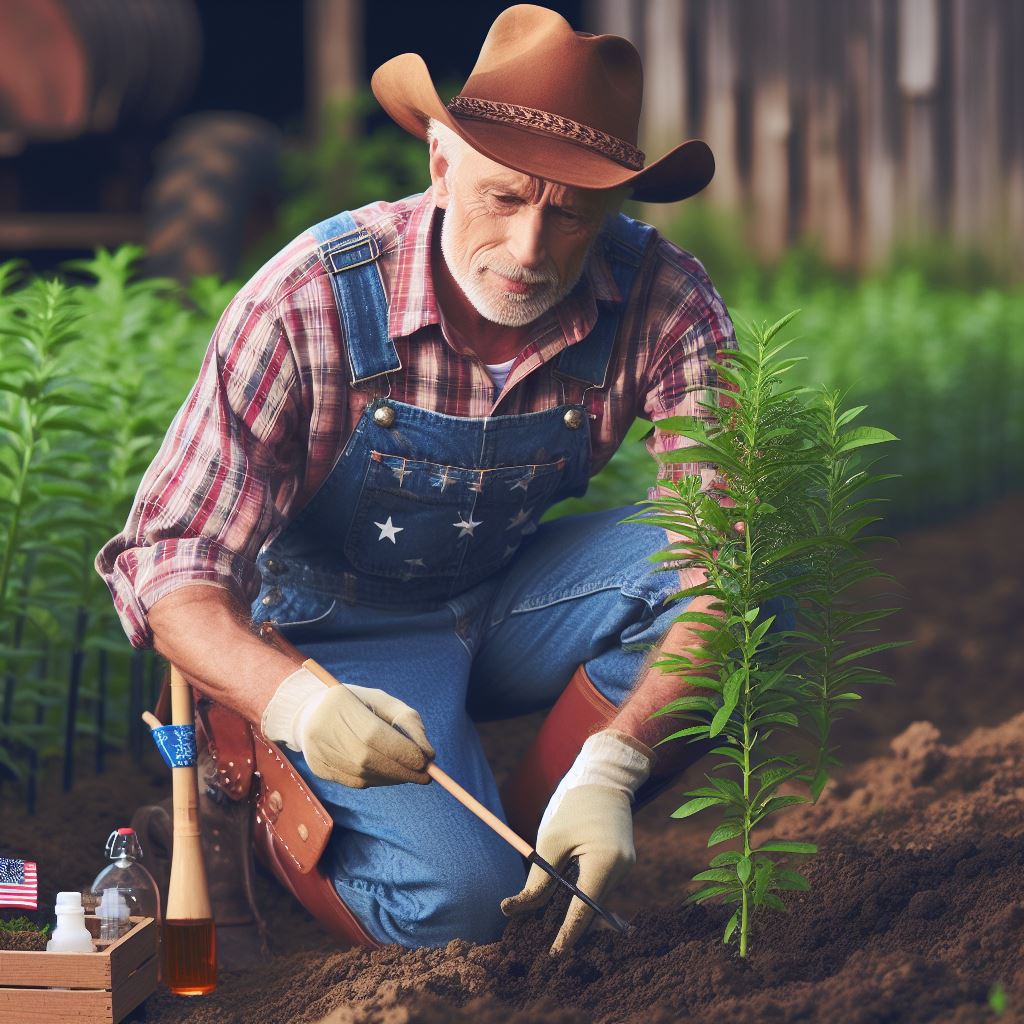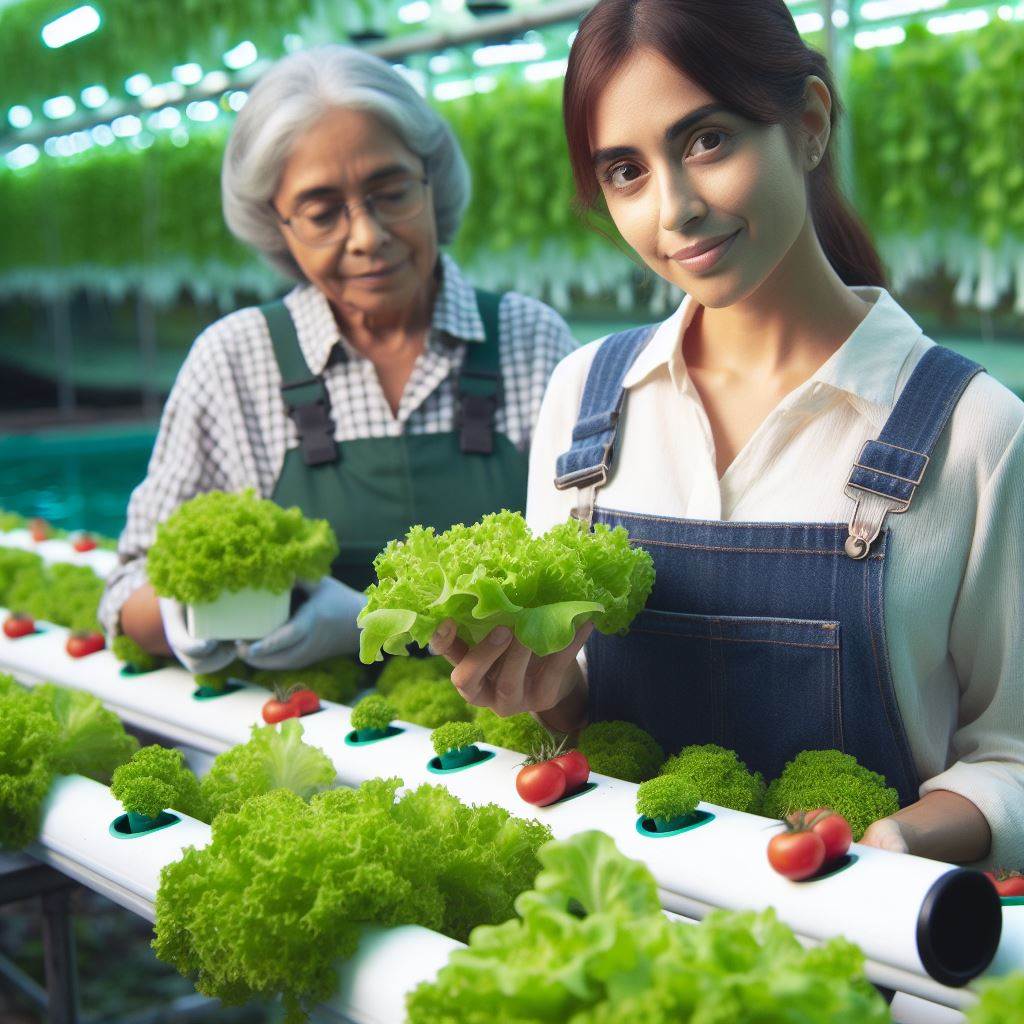Introduction
A. Definition and significance of vertical farming
Vertical farming is a revolutionary method of growing crops in vertically stacked layers.
Its significance lies in its ability to maximize food production in limited urban spaces.
This method is the future of urban agriculture because it addresses the challenges of land scarcity and the rapidly growing urban population.
Vertical farming offers numerous benefits such as increased crop yield, reduced water usage, and minimized transportation costs.
B. Why vertical farming is the future of urban agriculture
By utilizing advanced technologies such as hydroponics and aeroponics, vertical farming can produce higher yields compared to traditional farming methods.
With crops grown in controlled environments, farmers can optimize growth conditions, resulting in faster and healthier plant development.
Water scarcity is a pressing issue worldwide, but vertical farming requires significantly less water compared to conventional agriculture.
By recycling and reusing water within the system, vertical farms can conserve this precious resource.
Additionally, the proximity of vertical farms to urban areas reduces the need for long-haul transportation of produce, reducing energy consumption and carbon emissions.
Vertical farming also contributes to the preservation of natural resources.
By growing crops indoors, there is no need for pesticides and herbicides, thus reducing the harmful effects of chemicals on the environment.
Furthermore, vertical farms can be built on unused or abandoned urban spaces, revitalizing the cityscape and promoting sustainability.
Basically, vertical farming offers a promising solution to the increasing demand for food in urban areas.
Its efficiency, sustainability, and significant benefits make it the future of urban agriculture.
As technology continues to advance, vertical farming has the potential to transform our cities into self-sufficient and greener environments.
Transform Your Agribusiness
Unlock your farm's potential with expert advice tailored to your needs. Get actionable steps that drive real results.
Get StartedThe Concept of Vertical Farming
A. Brief history and origins of vertical farming
- Vertical farming can be traced back to the ancient Hanging Gardens of Babylon.
- Professor Dickson Despommier popularized the modern concept of vertical farming in 1999.
- Vertical farming gained momentum as a solution to address urban food production challenges.
- With the development of technology, vertical farming has become increasingly feasible and efficient.
B. The concept and how it differs from traditional farming methods
- Vertical farming is the practice of cultivating crops in vertically stacked layers or structures.
- Unlike traditional farming, vertical farming does not rely on large land areas for cultivation.
- Vertical farming utilizes artificial lighting and environmental control systems to optimize growth conditions.
- It minimizes the need for pesticides and eliminates the limitations of seasonal changes.
- Vertical farming also reduces water usage and allows year-round production in urban areas.
C. Overview of various types of vertical farming systems
- Hydroponic Systems: Plants are grown in nutrient-rich water without soil, using mineral nutrient solutions instead.
- Aquaponic Systems: Combines aquaculture and hydroponics, where fish waste provides nutrients for the plants.
- Aeroponic Systems: Plants are grown in a misty environment, with roots suspended in air and misted with nutrient solutions.
- Stacked Container Systems: Utilizes stackable containers or shelves for growing plants in a controlled environment.
- Vertical Greenhouses: High-rise structures with glass or transparent panels for maximum sunlight exposure.
- Plant Factories: Indoor facilities using artificial lighting and precise environmental controls for plant cultivation.
Vertical farming offers a sustainable and efficient approach to urban agriculture.
By utilizing vertical space and cutting-edge technologies, it addresses the challenges associated with traditional farming methods.
With continual advancements, vertical farming has the potential to revolutionize food production, ensuring a more secure and sustainable future.
Read: Top 5 Trends in Vertical Farming Tech
Advantages of Vertical Farming
Vertical farming has emerged as a game-changer in the field of urban agriculture.
By utilizing advanced technology and innovative methods, vertical farming offers significant advantages over traditional agricultural practices.
A. Maximizing land use efficiency
- Vertical farming allows the cultivation of crops in vertically stacked layers, resulting in maximized land utilization.
- This vertical arrangement enables farmers to grow more crops in a smaller footprint compared to conventional farming methods.
- By utilizing tall buildings and unused vertical spaces, vertical farming makes efficient use of available land resources, especially in densely populated urban areas.
B. Conserving water resources
- Water scarcity is a global concern, and traditional agriculture consumes vast amounts of water.
- Vertical farming adopts advanced irrigation systems, such as hydroponics or aeroponics, which require significantly less water compared to soil-based farming.
- These systems recycle and reuse water, reducing overall water consumption and minimizing the strain on water resources.
C. Reducing transportation costs and carbon emissions
- Conventional farming often requires long-distance transportation of produce from rural areas to cities.
- Vertical farming, when established in urban centers, minimizes the need for extensive transportation networks.
- By bringing food production closer to consumers, vertical farms reduce the carbon emissions associated with transportation, leading to a more sustainable food system.
D. Eliminating the need for pesticides and fertilizers
- Traditional farming relies on chemical pesticides and fertilizers to combat pests and enhance crop growth.
- Vertical farming, with its controlled indoor environment, significantly reduces the susceptibility to pests and diseases.
- This eliminates the need for harmful chemicals, making vertical farming a more environmentally friendly and healthier alternative.
E. Providing year-round crop production
- Vertical farming is not limited by seasons or weather conditions.
- By utilizing artificial lighting, temperature control, and hydroponic systems, crops can be grown throughout the year.
- This uninterrupted production eliminates seasonal fluctuations and ensures a consistent food supply, regardless of external factors.
Vertical farming brings about a host of advantages that have the potential to revolutionize urban agriculture.
Its ability to maximize land use efficiency, conserve water resources, reduce transportation costs and carbon emissions, eliminate the need for pesticides and fertilizers, and provide year-round crop production makes it a formidable solution for the future of food production.
Read: Vertical Farming: The Rise of Urban Agriculture
Challenges and Limitations
A. High initial setup costs
- Vertical farming requires substantial investment in infrastructure and technology.
- The expenses include constructing vertical structures, purchasing advanced lighting systems, and installing climate control systems.
- These costs can deter potential farmers from adopting vertical farming methods.
B. Energy consumption and reliance on artificial lighting
- Vertical farming relies heavily on artificial lighting, which can significantly increase energy consumption.
- The use of artificial lighting throughout the day can lead to higher electricity bills and environmental concerns.
- Incorporating renewable energy sources, such as solar panels, can mitigate this challenge but adds to the initial setup costs.
C. Technical complexity and potential for system failures
- Vertical farming systems require advanced technical knowledge and expertise to operate efficiently.
- The complexity of managing climate control, irrigation, and nutrient delivery systems can lead to system failures.
- System failures can result in crop losses, affecting the overall profitability and sustainability of vertical farming.
D. Limited crop variety and size restrictions
- Certain crops, such as tall trees or large root vegetables, are not suitable for vertical farming due to space constraints.
- Vertical farming is more inclined towards growing leafy greens, herbs, and smaller fruits like strawberries.
- This limitation restricts the variety of crops that can be cultivated, limiting the market potential for vertical farms.
Essentially, while vertical farming offers numerous benefits for urban agriculture, it also comes with certain challenges and limitations.
The high initial setup costs can be a significant deterrent for potential farmers, requiring substantial investments in infrastructure and technology.
Additionally, the reliance on artificial lighting leads to increased energy consumption and higher electricity bills.
The technical complexity of managing vertical farming systems poses a risk of system failures, potentially resulting in crop losses.
Finally, the limited crop variety and size restrictions in vertical farming restrict the types of crops that can be cultivated.
Despite these challenges, continued research and technological advancements may help overcome these limitations, making vertical farming a viable solution for sustainable urban agriculture in the future.
Read: Smart Farming: Revolutionizing Agriculture Tech

Learn More: Drone Tech in Pest Control: A Study
Successful Examples of Vertical Farming
A. Overview of well-known vertical farming companies
- AeroFarms, based in New Jersey, is one of the world’s largest vertical farming companies.
- Growing Underground, located in London, specializes in growing vegetables and herbs in abandoned underground tunnels.
- Juan Bravo Vertical Farm in Madrid, Spain, uses aeroponics to grow lettuce and leafy greens.
- Indoor Harvest Corp in Texas focuses on inventing, developing, and commercializing aeroponic equipment for vertical farming.
- Vertical Harvest, situated in Wyoming, operates a three-story vertical greenhouse that provides jobs for people with disabilities.
B. Case studies of successful vertical farms in urban areas
- Plantagon, in Linköping, Sweden, is a vertical farm that uses excess heat from nearby industries for sustainable production.
- “The Plant” in Chicago, Illinois, is a vertical farm that combines aquaponics and hydroponics to grow a wide range of food products.
- Green Sense Farms, located in Indiana, has developed a fully automated vertical farming system that maximizes space efficiency.
- Vertical Field, an Israeli company, designs and operates urban vertical farms that use IoT technology to optimize plant growth.
- Farmony, based in Seoul, South Korea, transforms abandoned factories into vertical farms using hydroponic and LED lighting systems.
C. Positive impacts of vertical farming on local communities
- Vertical farming reduces transportation costs and carbon emissions by producing food locally.
- It provides year-round access to fresh produce and helps address food insecurity in urban areas.
- Vertical farms create employment opportunities and contribute to the local economy.
- By using efficient watering systems, vertical farming conserves water and reduces water pollution.
- These farms can be set up in unused urban spaces, promoting urban revitalization and sustainable development.
Vertical farming has gained momentum as an innovative solution to modern agricultural challenges, and several successful examples stand out.
In general, various successful examples illustrate the potential of vertical farming to revolutionize urban agriculture and positively impact local communities.
Read: Sky Farming: Drones and Their Impact
The Future Prospects of Vertical Farming
A. Potential for vertical farming in addressing global food security issues
Vertical farming has the potential to address global food security issues by providing a sustainable solution.
As the world population continues to grow rapidly, traditional farming methods are not enough to feed everyone.
By utilizing vertical farming techniques, crops can be grown in stacked layers, maximizing the use of limited space.
This allows for increased production and efficiency, leading to higher yields compared to traditional agriculture.
Showcase Your Farming Business
Publish your professional farming services profile on our blog for a one-time fee of $200 and reach a dedicated audience of farmers and agribusiness owners.
Publish Your ProfileAdditionally, vertical farming can reduce the dependency on weather conditions and natural resources such as water and land.
Controlled environments provide optimal conditions for plant growth and minimize the use of pesticides and herbicides.
B. Integration of vertical farming with smart city concepts
Integration of vertical farming with smart city concepts is another exciting prospect for the future.
Smart cities focus on using technology to enhance the quality of life for their residents.
Vertical farming fits perfectly into this vision.
Vertical farms can be integrated into urban areas, allowing fresh produce to be grown and harvested locally.
This reduces the need for transportation and storage, resulting in fresher and healthier food options for urban dwellers.
Furthermore, vertical farms can be connected with smart sensors and automation systems, enabling real-time monitoring and control of various factors such as temperature, humidity, and nutrient levels.
This ensures optimal growing conditions and reduces the risk of crop failure.
C. Growth predictions for the vertical farming industry
The growth predictions for the vertical farming industry are promising.
The global vertical farming market is expected to reach a value of $12.8 billion by 2026, growing at a CAGR of 24.8% from 2019 to 2026.
Several factors contribute to this anticipated growth.
Firstly, increasing urbanization and the scarcity of arable land are driving the need for alternative farming methods.
Vertical farming offers a viable solution by utilizing unused vertical space.
Moreover, the growing demand for organic and locally sourced produce is fueling the interest in vertical farming.
Consumers are becoming more aware of the environmental impact of food production and are willing to pay a premium for sustainable options.
Additionally, advancements in technology and lighting systems are making vertical farming more efficient and cost-effective.
LED lights and hydroponic systems allow for precise control over plant growth, resulting in higher productivity.
Investors and entrepreneurs are also recognizing the potential of vertical farming.
Numerous startups and companies are entering the market, developing innovative solutions and driving further research and development in the field.
In essence, the future prospects of vertical farming are promising.
With its potential to address global food security issues, integration with smart city concepts, and projected industry growth, vertical farming is set to revolutionize urban agriculture.
By embracing this sustainable farming method, we can create a greener and more food-secure future.
Conclusion
A. Recap of the importance and benefits of vertical farming
Vertical farming offers numerous benefits such as maximizing land usage, reducing water usage, minimizing transportation costs, and increasing crop yield.
B. Encouragement for further exploration and implementation of vertical farming
It is crucial to continue researching and investing in vertical farming techniques to meet the growing demand for food in urban areas.
C. Final thoughts on the potential impact of vertical farming on urban agriculture and sustainable food production
Vertical farming has the potential to revolutionize urban agriculture, making cities self-sufficient in food production and contributing to a more sustainable future.
By incorporating vertical farming methods, we can ensure a consistent supply of fresh, locally grown food.
Moreover, this innovative approach can reduce the environmental impact associated with traditional farming methods, such as deforestation and pesticide use.
As we face population growth and limited arable land, vertical farming provides a promising solution to sustainably feed urban populations.
It is an exciting prospect that combats food insecurity, reduces food miles, and promotes a healthier and more environmentally conscious way of life.
Therefore, governments, organizations, and individuals should support and invest in the development and implementation of vertical farming.
Research and technological advancements can further refine and optimize vertical farming systems, making them more accessible and cost-effective.
In the end, vertical farming represents the future of urban agriculture by addressing the challenges of food security, environmental sustainability, and efficient land use.
With continuous efforts, vertical farming can transform our cities into self-sufficient hubs of fresh and nutritious food production.
Let us embrace this innovative approach and unlock the immense potential of vertical farming for a greener and more sustainable future.




